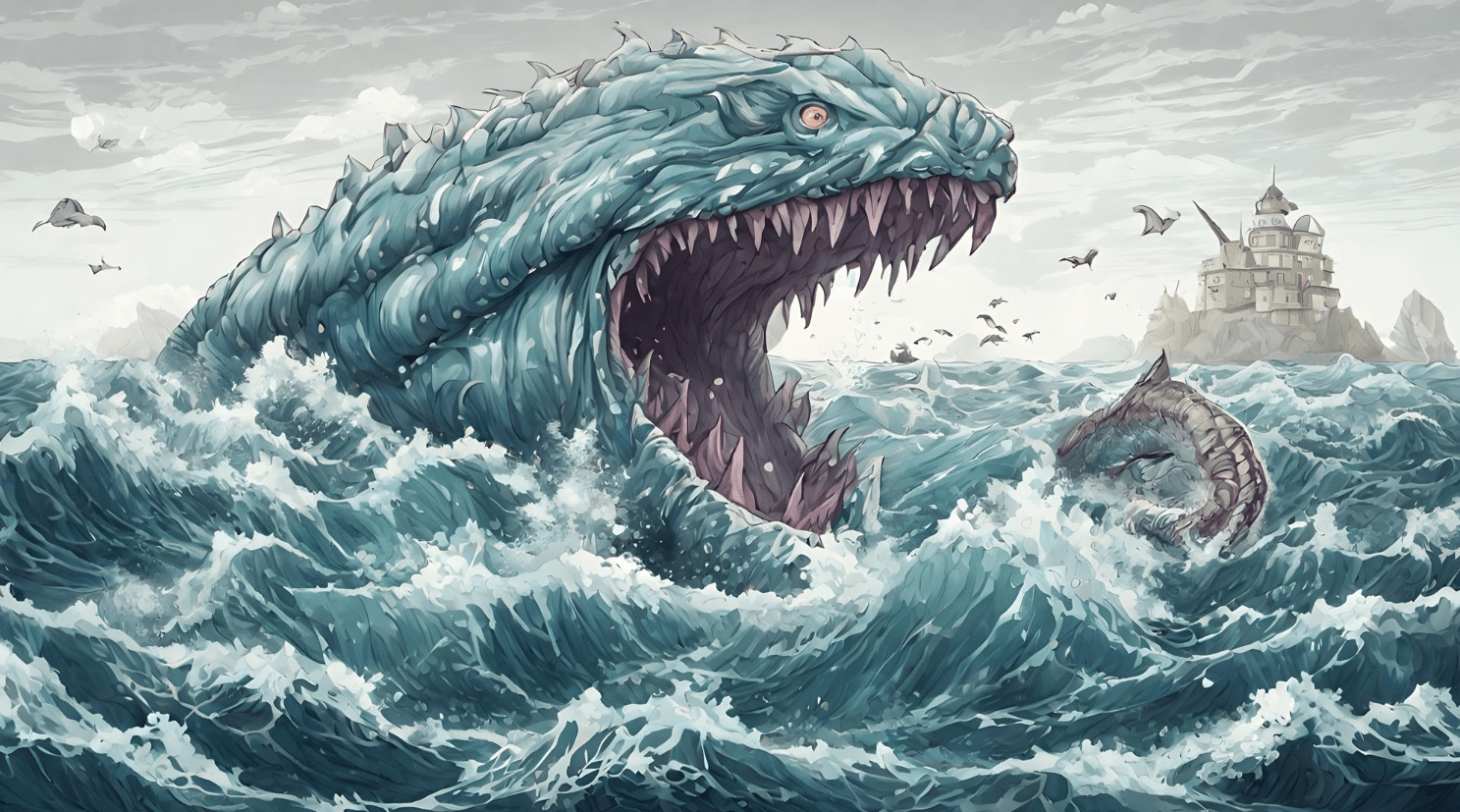Millions of years ago, the world was dominated by ancient giants called the megalodons. These prehistoric creatures often referred to as the “monsters of the deep,” were the largest sharks that ever lived, and their existence has fascinated scientists and storytellers alike. In this article, we embark on a thrilling journey to unravel the mysteries of megalodons and explore the captivating realm of fossilized giants.
With their massive bodies, razor-sharp teeth, and powerful jaws, megalodons ruled the oceans for over 20 million years. But what led to their extinction? How did they hunt? And what can their fossils teach us about the Earth’s history? We’ll explore the latest scientific findings, examine their lifestyle and ecosystem, and admire the incredible size and power of these ancient predators.
Join us as we dive deep into the depths of the past to uncover the secrets of megalodons. From fossil records to modern-day discoveries, we’ll navigate through a sea of knowledge and ignite your imagination. Brace yourself for a jaw-dropping adventure into the fascinating world of these colossal creatures.
History and Discovery of Megalodon Fossils
The story of megalodons begins with the discovery of their fossils. The first recorded mention of megalodon teeth dates back to the 17th century, but in the 19th century, scientists started to recognize them as belonging to a distinct species. The renowned paleontologist Louis Agassiz played a crucial role in identifying and naming these ancient giants. Since then, numerous megalodon fossils have been unearthed around the world, providing valuable insights into their existence.
Megalodons’ fossils are typically found in marine deposits, such as sedimentary rocks and ancient sea beds. These fossils are often well-preserved, thanks to the mineralization process taking place for over millions of years. Through careful excavation and analysis, scientists have been able to piece together the puzzle of megalodon’s history and gain a deeper understanding of their biology and behavior.
The study about these fossils has not only shed light on the existence of these colossal creatures but has also contributed to our knowledge of the Earth’s past. By examining the age and location of the fossils, scientists have been able to reconstruct ancient marine environments and track the changes that have occurred over time. The discovery of megalodon fossils continues to captivate researchers and enthusiasts, fueling the ongoing quest for knowledge about these ancient giants.
Size and Characteristics of Megalodons
When we discuss the topic of size, megalodons were genuinely unparalleled. These massive sharks could reach up to 60 feet, making them significantly larger than their closest living relatives, the great white sharks. The sheer size of megalodons is awe-inspiring, and their teeth, some measuring over 7 inches in length, are a testament to their formidable presence.
This size wasn’t the only impressive aspect of megalodons. These ancient predators possessed a set of razor-sharp teeth and powerful jaws capable of crushing through bone. Their teeth, designed for grasping and tearing prey, were continuously replaced throughout their lifetime. By examining the wear and tear on megalodon teeth, scientists have gained insights into their feeding habits and the types of prey they target.
Megalodons were apex predators, ruling the oceans with an iron grip. They were well-adapted to their environment, with a streamlined body shape and powerful muscles that allowed them to swim swiftly and efficiently. While much of their biology remains a mystery, scientists continue to study their anatomy to reconstruct the life and habits of these awe-inspiring creatures.
Megalodon’s Place in the Prehistoric Ecosystem
Exploring their place in the prehistoric ecosystem will provide us with an understanding of the degree of their importance. These ancient giants occupied the top of the food chain, significantly influencing the marine life around them. They played a crucial role in maintaining the balance of the oceanic ecosystem as apex predators.
Megalodons primarily fed on large marine mammals, such as whales and seals. Their powerful jaws and massive size allowed them to take down even the largest prey easily. By studying the bite marks found on fossilized whale bones, scientists have been able to estimate the force and techniques megalodons used to hunt their prey.
The presence of megalodons in the prehistoric oceans shaped the evolution of other marine species. The constant threat of predation influenced the behavior, size, and distribution of smaller marine animals. Some species developed defensive adaptations, such as increased speed or protective armor, to avoid becoming megalodon’s next meal.
Understanding the role of megalodons in the prehistoric ecosystem is crucial for comprehending the past and predicting the future. By examining the interactions between ancient apex predators and their environment, scientists can gain insights into the potential consequences of losing these critical species in today’s ecosystems.
Fossilized Evidence of Megalodons
The fossilized remains of megalodons provide a wealth of information about their existence and behavior. Apart from teeth, which are the most commonly found fossils, other skeletal elements have also been discovered, including vertebrae, jaws, and even fossilized feces (known as coprolites). Each fossilized find adds another piece to the puzzle of the megalodon’s story.
With the help of analysis made of the shape and size of megalodon teeth, scientists can estimate the age and growth rate of these ancient sharks. The study of growth rings on teeth, similar to those found in tree trunks, has revealed valuable insights into the lifespan and development of megalodons. These findings have dispelled some common misconceptions about the species and provided a more accurate understanding of their biology.
Fossilized vertebrae offer additional clues about the size and movement of megalodons. These bones provide information about the structure of their spine, allowing scientists to estimate their agility and maneuverability in the water. The presence of healed injuries on some vertebrae suggests that megalodons were not invincible and occasionally engaged in fierce battles with other predators.
Coprolites, or fossilized feces, provide a unique window into the megalodon’s diet and digestive system. By analyzing the contents of coprolites, scientists have been able to identify the remains of prey species, offering valuable insights into the hunting habits and dietary preferences of these ancient creatures.
Theories about the Extinction of Megalodons

One popular theory suggests that the decline of megalodons was closely tied to changes in the marine environment. As the Earth’s climate shifted, sea levels fluctuated, leading to the disappearance of their preferred habitats. The reduction in prey availability and changes in ocean currents may have contributed to the decline of the megalodons’ population.
Another theory proposes that the emergence of new competitors played a role in the extinction of megalodons. The evolution of smaller, more agile predators, such as the great white shark, may have put pressure on megalodons by outcompeting them for resources. The rise of these new competitors, combined with the changing environment, could have spelled doom for the megalodons.
Some scientists argue that a combination of factors, including climate change, competition, and changes in prey availability, led to the decline of megalodons. The exact sequence of events and the relative importance of each factor remains uncertain. The extinction of megalodons serves as a reminder that even the most formidable creatures can be vulnerable to environmental changes.
Megalodon Myths and Misconceptions

One of the most common misconceptions is the belief that megalodons still exist in the deep, unexplored parts of the oceans. Despite occasional claims and rumors, no scientific evidence supports the existence of living megalodons. The extinction of these creatures occurred millions of years ago, and their remains are found exclusively in the fossil record.
Another myth surrounding megalodons revolves around their size. While they were undoubtedly massive, some depictions in popular culture have exaggerated their dimensions to monstrous proportions. The largest confirmed megalodon specimen reached lengths of around 60 feet, significantly smaller than some portrayals suggest.
Megalodons also suffer from the misconception that they were mindless killing machines. While they were undoubtedly powerful predators, their behavior was likely more complex than simply attacking anything in sight. Like their modern relatives, megalodons probably had specific hunting strategies and targeted certain prey species.
Separating fact from fiction is crucial when examining the legacy of megalodons. By dispelling myths and misconceptions, we can appreciate these ancient creatures for what they were – fascinating and awe-inspiring, without exaggeration.
Famous Megalodon Discoveries and Exhibits
The allure of megalodons has not been limited to the scientific community. Over the years, their fossils have captured the public’s imagination, leading to numerous discoveries and exhibits dedicated to these ancient giants.
One of the most significant megalodon discoveries occurred in the 1980s when a nearly complete skeleton was found in the coastal cliffs of Peru. This remarkable find provided scientists with a wealth of information about the megalodon’s anatomy and allowed for detailed reconstructions of these creatures.
Museums around the world have capitalized on the public’s fascination with megalodons by showcasing their fossils in captivating exhibits. From life-size reconstructions to interactive displays, these exhibits offer visitors a chance to marvel at the size and power of these ancient predators.
Megalodons have also made their way into popular culture in recent years through books, movies, and documentaries. Authors and filmmakers have drawn inspiration from the mysteries surrounding megalodons, weaving tales of thrilling encounters and exploring the potential impact of their existence on the world today.
Conclusion: The Enduring Fascination with Megalodons
The mysteries of megalodons continue to captivate our imagination. From their discovery in the fossil record to the ongoing debates about their extinction, these ancient giants have left an indelible mark on our understanding of the Earth’s history.
Through the study of megalodon fossils, scientists have gained invaluable insights into the past, unraveling the secrets of these colossal creatures. The enduring fascination with megalodons is a testament to their awe-inspiring size, power, and the sense of wonder they evoke.
While we continue to explore the depths of our oceans and solve the mysteries of the past, the legacy of megalodons will remain an enduring testament to the vastness and diversity of life on Earth. Whether through scientific discoveries, museum exhibits, or creative works, the story of megalodons will continue to spark our imagination and inspire future generations to explore the unknown depths of our planet.

Mary Wright is a professional writer with more than 10 years of incessant practice. Her topics of interest gravitate around the fields of the human mind and the interpersonal relationships of people.If you have a general question or comment please fill out the form and we will get back to you as soon as possible https://curiousmindmagazine.com/contact-us/ .




